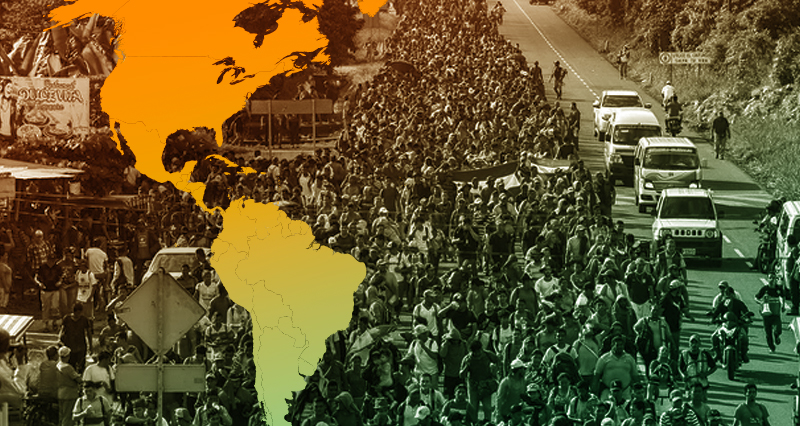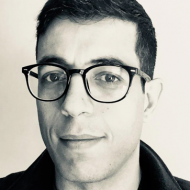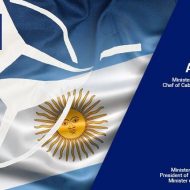It is well known that the mass migration issue is a widespread problem throughout the world. It is a phenomenon that exceeds civil society institutions, political parties and governmental capabilities. Crucial for capitalism in the 21st century, think tanks define it as a “global challenge” that threatens the established liberal order already in crisis. In Central America, there are several migratory flows that are building in intensity. They are the consequences of the failures of imperialism’s policies on the continent and result of the inexhaustible action of the popular masses. In this article, we will highlight what is happening in Mexico and the Northern Triangle (El Salvador, Guatemala, Honduras) regarding the migrant caravans heading to the US, a situation which is becoming more complex by the day, catalyzed by the coronavirus pandemic and natural disasters in societies in permanent crisis. The Biden administration has a wide range of interests to address in the region. However, migration remains its priority. Here, we will attempt to elucidate the US’ and Biden’s strategy for the region.
Honduras and the reasons for migration
In Honduras, there is a permanent and spiraling crisis. For Hondurans, 2020 signaled a catastrophic collapse. The country was already beset by corruption and poverty when the Covid pandemic amplified the critical social and economic crisis. In November things got worse: a fatal hurricane season (Eta and Iota, category 4 and 5 respectively) started in the country as tropical storms producing enormous destruction, causing severe infrastructure damage. The Sula Valley, where 60% of the country’s GDP originates, was particularly affected. There were a hundred deaths and more than 4 million people directly affected (nearly half its population). Losses are estimated at around $10 billion. Hundreds of thousands of people were displaced. Almost 100,00 were still in shelters in last January, and thousands are still living in encampments and in the streets.
The Honduran economy is not poised to overcome the situation. Honduras is the poorest country of mainland Latin America, with a GDP of $25,000 million. At the beginning of 2020, 60% of the country’s inhabitants were poor. This year, after the impact of the pandemic, the index climbed to 70%, while 40% of the total population is living in extreme poverty.
This country has been a key player at Washington’s disposal since the 2009 coup d’etat. The overthrow and kidnapping of Mel Zelaya not only halted the progress of integration of the Bolivarian Alliance for the Peoples of Our America (ALBA), but also repositioned the nation as the epicenter of US activities in the region. After the coup, sponsored and carried out in collaboration with the US, Honduras became the link in the militarized corridor from Colombia to Mexico. The country represents a geostrategic asset for the US as it is in the center of Central America and has access to the Pacific Ocean and the Caribbean Sea.
Honduran families and workers, most of them poor, are the main component of the migrant flows that heads towards the US. During 2019, the US apprehended more than 250,000 Hondurans at the southern border. The US border apprehensions and expulsions of Hondurans reached a low of 1,746 in May 2020, since then, the number began to rise significantly. By December, after the hurricanes, the number leapt to 10,351 according to US Customs and Border Protection data.
Popular response: Migrant Caravans
In 2018, the most recent migration crisis broke into multiple human rivers, the “migrant caravans”, social movements that move across Central America trying to reach the US border through a collective journey of almost 4,000 km. They are young people, men, children and women who leave their countries in search of worthy work and quality of life to get out of hunger, and escape violence and structural poverty. Under this method –that initially arose in the early 2000’s in response to the transnational policies of migration control and refugee management in the US and Mexico, the journey becomes feasible, because it provides a degree of safety against many of the dangers and challenges that arise along the way.
At the end of January 2020, we saw the most recent expression, a human column of at least 8,000 migrants and asylum seekers that began the journey in Honduras, entered Guatemala and was detained and dispersed through repression by the government. Most of these people had to go back to where they came from. On January 18, the government’s negotiation attempts failed, and hundreds of soldiers and police cleared people off the highway.
Those same people took part in the first Migrant Caravan, incited on October 12, 2018 when 200 self-convened in San Pedro Sula (Honduras) to arrive at the US border on foot. By the time the caravan crossed the border into Guatemala, there were already 4,000 people. By October 23, they were around 10,000 crossing the territory of Chiapas, Mexico.
The reasons these migrants decide to leave their country will persist and may deepen. Poverty and hunger are structural. On top of this, climate change has made hurricanes stronger and wetter. This has resulted in an ideal situation for the US’ interventionist activities, once again masked by ostensible international humanitarianism and NGO activity.
Each country plays a role
The relationship between Mexico and the US has been hijacked by two main issues: trade and migration. In 2019, facing an increase in Central American migrants who were crossing Mexico heading north, Trump threatened to impose tariffs on all Mexican exports unless the López Obrador government took steps to halt the migrants. The Mexican government agreed to militarize its border with Guatemala in exchange for the installation of development programs for Central America in order to stop and discourage migrations, generating jobs, granting subsidies, promoting development projects, local investment, financing reconstruction and infrastructure development. This was similar to the efforts to curb and stop migratory flows implemented by Obama in last the 2014 migration crisis when he urged Mexican authorities to crack down on illegal migration while offering incentives for people to stay in their countries or at least in some country before arriving before reaching the southern border of the US (especially Mexico).
Mexico is consolidating its role in this process. Migrants passing through its borders come from all countries in the region. In the scheme proposed by the US, the objective is to bolster Mexico as the last security filter. Thousands will be detained and deported from there. Mexico usually deports more Central Americans than the US. Thousands more will apply for asylum. In 2019, there were 70,000 requests– an all-time high. The country has agreed to continue this program. In 2019, Obrador agreed with Trump on the development of the “Stay in Mexico” program, which forces migrants to wait in Mexico during their asylum procedures (now suspended by Biden). Long before the pandemic, Mexico had become the betrothed destination for many Central Americans. In 2019, more than 30,000 Hondurans requested asylum there.
The Mexican Foreign Ministry announced in June 2019 that they will transform the “migration stations” –that is, the places where illegal migrants gather after being detained in Mexican territory, into “refugee camps” (Chiapas, Baja California Norte, Chihuahua) where more than 25,000 people are currently awaiting refuge, asylum or deportation. These refugee camps are turning into an ordinary figure in the Latin American landscape. One such camp is in the south of Panama (Darién province, La Peñita), where 1,500 irregular migrants constitute another migrant flow: people coming from Haiti, Cuba, Bangladesh, Congo or Cameroon. In 2019, some 24,000 people crossed the Darien jungle from Colombia trying to reach México and the US.
Guatemala, for its part, has served as a barrier. The influence of the US and the pro-imperial stance of its government have led the country to prevent any attempt to collectively cross the country into Mexico. Militarized checkpoints were settled throughout the country while security forces concentration has shifted from the border areas with Honduras to the border areas with Mexico where smaller groups of migrants and asylum seekers have been arriving. Guatemala opened its borders in September 2020 after six months of closure due to the pandemic, but non-residents must present a negative COVID-19 test result upon entry. Only 70 Hondurans arriving with the caravan did so, and the Guatemalan government cited public health issues to justify its crackdown on the caravan. The policies of the countries in the region with respect to migratory flows are dictated by Washington. Faced with this year’s migrant caravan, the governments of Honduras and Guatemala implemented measures in the same line of action that has been taking place since 2018: contain and dismantle contingents at the point of origin, deployment of militarized security forces to prevent the passage of migrants.
Strategic lines
It is clear that the situation in Mexico and the Northern Triangle is largely tied to what the White House decides. Mass migration is a strategic problem that affects Washington interests in a region that historically has allowed the US to establish itself as an imperial power during the 20th century. Biden’s plan calls for more interference based on a conception of Central America as a board of manipulable pieces to fight a massive popular movement that is rushing towards the imperial center, and threatens to become a massive social factor that could stress the country’s stability.
The day Biden took office, he signed 17 Executive Orders, almost half of them related to immigration matters. Among other elements, he announced an 8-years program that seeks to recognize 11 million undocumented immigrants and vowed to invest $ 4 billon over 4 years in Central America, to be carried out in partnership with multilateral development banks, such as the World Bank and the Inter-American Development Bank. The intention is to address the underlying causes of immigration, that is, to make every effort so that those who are going to migrate stay in their countries or in any case, desist from reaching the US, settling along the way by choice or by being forced to do so. Biden’s course of action will be the same as that carried out while he was Obama’s vice president. In 2014, during the previous immigration crisis, Biden achieved consensus between Democrats and Republicans in Congress to invest $750 million in reforms in the region. This included transformations in the security and rule of law systems, the same idea expressed in the Biden 2020 electoral platform: direct investment in the local economy, employment creation, financing of local activities, infrastructure development, etc., that is, the transformation of societies according to Washington’s interests.
The reaction of the US regime has already been expressed by the new Biden administration. Beyond the xenophobic and reactionary imprint of Trump’s immigration policy, we can find evident continuity with the administrations that preceded him and what we have already seen from Biden. Roberta Jacobson, former US ambassador to Mexico and assistant secretary for Western Hemisphere Affairs from 2012 to 2016 (during which time she led US negotiations to normalize relations with Cuba), has been now appointed as the coordinator of the southwestern border on the National Security Council. She made it very clear in a press conference addressing the migrants who were advancing from Honduras to Guatemala: “Do not come, you endanger yourself, your families and companions. Now is not the time to reach the border with the US. The circumstances at the border have not changed”. For his part, William Popp, the US Ambassador to Guatemala, declared “Regarding any intention to form a caravan, our message is clear: our border remains closed for those who try to enter illegally.” This situation was also plainly reflected in the measures taken by a federal judge in Texas who issued a temporary restraining order that blocks Biden’s 100-day deportation moratorium nationwide (a main part of a package of immigration-reform measures the new administration proposed on Inauguration Day).
The US cannot show that its borders are insecure and that they can be easily breached en masse. The migrant flow could incise and transform the already fragile social and political situation in the US. That is why we can expect that the new administration will deploy all the instruments at its disposal to try to stop these massive migratory flows of the Latin American poor, who incarnate the consequences of decades of imperial interference and dependency policies, exposes the vulnerability and stresses the circumstances at a time of systematic uncertainty for capitalism and the liberal world order.
The new US administration is already acting in continuity with the country’s long running policies of interference in the region. This outlook is rooted in imperialist ideology and exceptionalist philosophy, resulting in the stubborn repetition of what has already shown disastrous results. This is also a manifestation of the imperial decline, a reflection of the inability to reproduce domination and hegemony, and a clear demonstration that when the people move together, no one can stop them.









Leave a Reply